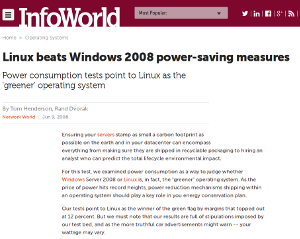The upgrading and maintenance of technology uses up a lot of universities’ resources so many are conscious of keeping these costs down. Paolo Vecchi, an advocate of open source technology, argues that now is the time for universities to rethink their ICT provision in a bid to cut their energy costs.
I’ve noticed that Jisc has recently updated an article about ICT energy costs reduction, which stated that universities and colleges spend about £147m a year just in ICT related energy costs.
The article rightly recommended various methods to save energy, but I think that Jisc has forgotten mention an important one.
There is a limit to what can be saved if organisations keep using the same tools. Changes needs to be made in the education sector, like many other sectors, but you might be surprised to find that technology that you are probably already using will help to cut your energy costs.
The solution is staring you in the face
The vast majority of services provided on what people call the internet or “Cloud”, from supercomputers to your mobile phone, all have the same thing in common: they all run on the operating system Linux and open source applications.
There are many reason why Linux has been chosen as the base for so many and diverse applications, including:
-
it’s open source so it can be adapted to all sorts of workloads and platforms
-
it doesn’t have licensing costs or legal limitations on it use
-
it’s extremely efficient so you can get more out of your device or infrastructure
Looking at the Jisc article’s supporting documentation that goes back to 2008. Linux is not mentioned at all, but there is a brief reference to “different software that can have different energy consumption”. Looking through the notes I found the link to the article it was referring to which talks about Linux being better than Windows 2008 with power saving measures.
It is difficult to find a recent efficiency comparison between Linux and Windows server workloads as the issue was settled a long time ago, showing that for the same type of workloads Linux and Open Source are the best choice.
Even Microsoft itself runs popular applications like Skype and Yammer on thousands of Linux servers instead of Windows so if you believed for many years that Windows was the best choice, then follow Microsoft’s example and start using Linux.
Keep always in mind that while hosted applications and renting someone else’s computers, or in simple terms using the “Cloud”, may seem a good idea it may not help you at all as you’ll just pay somebody else’s electricity bill together with their costs and profits. Evaluate which services can be upgraded to work with Linux and consolidate workloads first, then you may finally see that Cloud is not as efficient as you thought.
How much energy could be saved by switching from Windows to Linux?
I’ve seen even small organisations deploying Windows to run their email platform, file sharing and a few other applications on servers that consume as much energy as a small electric oven. Equivalent solutions can be run on Linux servers with little more energy than a laptop and the users won’t see the difference in performance between the two. The only person that will see the difference is the person paying the bill.
In a few universities I’ve noticed that email, storage and web services for students are all run on Linux systems while the staff and professors use Microsoft products. In one case, 2,000 staff use the same amount of resources required to provide the same services to 12,000 students. Why duplicate infrastructures and costs when both staff and students can get top quality services from an efficient and reliable Linux platform?
Is not easy being green
It’s probably a lot easier to renew the usual enterprise agreement and maybe deploy Office365 as it’s “free”, if your school purchased a campus Office licence. But that doesn’t allow for long term savings, it just moves high costs around and it creates a situation where it will be even more difficult over time to move freely to more suitable technologies.
We want to produce a generation of creative and inquisitive minds that will be the new driving force of our society. Students using closed source products will just create a new generation of consumers.
The education sector is supposed to be run by the brightest minds available to form our future CEOs and scientists so, with Jisc playing a central role, it should be the first to lead by example and show students that with a small effort, it is possible to create innovation, efficiency and savings.
Paolo Vecchi works for Omnis Systems Ltd, which is based at the University of Sussex’s innovation centre








